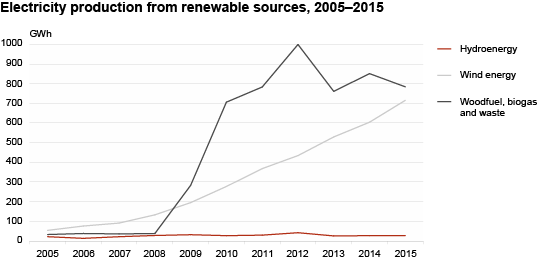Electricity production decreased last year
Electricity generation decreased due to cheaper inflows of electricity from the Nordic countries. Imports from Finland grew 1.5 times in 2015 compared to the year before and constituted more than 96% of total electricity imports. At the same time, electricity consumption was at about the same level as the year before. Despite the decrease in production, annual electricity generation exceeded domestic consumption.
In the recent years, there has been a significant increase in the production of electricity from renewable sources. The introduction of renewable sources has somewhat reduced the importance of waste-intensive oil shale in electricity production. While in 2010 over 85% of electricity was generated from oil shale, the relevant share was 77% in 2015.
Since 2009, about half of the produced renewable electricity has been generated from biomass. There has been a considerable increase in the consumption of waste fuel and biogas for electricity generation. The production of wind power has also increased year by year. In 2015 it grew 18.4% compared to 2014. The volume of hydro energy has not changed significantly in the past three years, accounting for only 2% of total renewable electricity production.
In the past five years, the volume of oil shale production has increased every year but in 2015 production decreased approximately 7% compared to the previous year. The majority of oil shale is consumed in power plants and as raw material for shale oil. In 2015, compared to 2014, the consumption of power plants decreased by approximately 20%. Due to the continued demand in foreign markets, the shale oil production volume has increased year by year. In 2015, compared to 2014, the production of shale oil grew about 20%, and 90% of the production was exported. More than half (61%) of the exported shale oil was exported to the Netherlands, followed by Belgium and Sweden (10% each).
Over the past five years, wood pellets have been an important fuel on the energy market. In that period, the production of pellets has increased more than three times. Compared to 2014, the production of pellets grew 44% in 2015, with approximately 80% of the wood pellets produced being exported. More than half (57%) of the exported wood pellets were exported to Denmark, followed by the United Kingdom (27%), Sweden (10%) and the Netherlands (10%).
The production of peat fuels has been in decline for the past five years. In 2015, compared to 2014, the volume of production decreased more than two times.